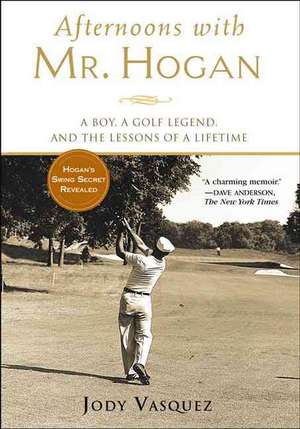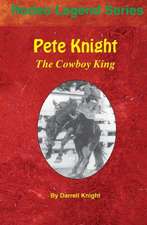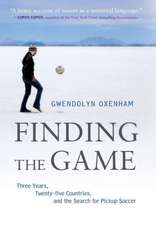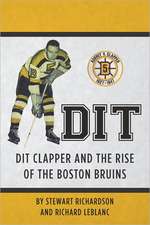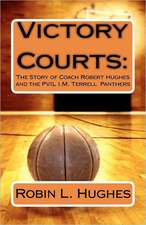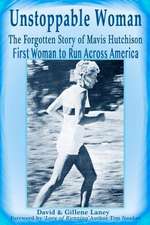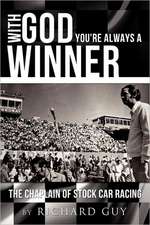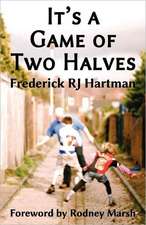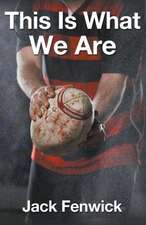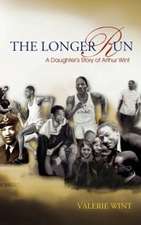Afternoons with Mr. Hogan
Autor Jody Vasquezen Limba Engleză Paperback – 31 mar 2005
Ben Hogan's former ball shagger recounts firsthand stories of the golf legend—andreveals, for the first time, Hogan's Swing Secret, a source of mystery to golfers for more than fifty years.
Ben Hogan's pro golf record is legendary. A four-time PGA Player of the Year, he celebrated sixty-three tournament wins and became known as a man of few words and fewer close friends. Most of what we know about Hogan has been based on myth and speculation. Until now.
In the 1960s, though Hogan's competitive career was over, he kept the practice habits that made him famous and remade modern competitive golf. He hired seventeen-year-old Jody Vasquez to help. Each day, after driving to a remote part of the course at Shady Oaks Country Club, Hogan would spend hours hitting balls and Vasquez would retrieve them. There, and over the course of their twenty-year friendship, Hogan taught Jody the mechanics of his famous swing and shared his thoughts on playing, practicing, and course management—unknowingly revealing much about his character, values, and beliefs, and the events that shaped them.
In Afternoons with Mr. Hogan, Jody Vasquez shares dozens of stories about Hogan, from the way he practiced, selected his clubs, and interacted with other star players to his little-known humor and generosity. Combining the gentle insight of Tom Kite's A Fairway to Heaven (which recalls Kite's golf education under Harvey Penick) with the sage perspective of Penick's own Little Red Book, Vasquez's tribute is funny, poignant, and full of advice for golfers of all levels.
Ben Hogan's pro golf record is legendary. A four-time PGA Player of the Year, he celebrated sixty-three tournament wins and became known as a man of few words and fewer close friends. Most of what we know about Hogan has been based on myth and speculation. Until now.
In the 1960s, though Hogan's competitive career was over, he kept the practice habits that made him famous and remade modern competitive golf. He hired seventeen-year-old Jody Vasquez to help. Each day, after driving to a remote part of the course at Shady Oaks Country Club, Hogan would spend hours hitting balls and Vasquez would retrieve them. There, and over the course of their twenty-year friendship, Hogan taught Jody the mechanics of his famous swing and shared his thoughts on playing, practicing, and course management—unknowingly revealing much about his character, values, and beliefs, and the events that shaped them.
In Afternoons with Mr. Hogan, Jody Vasquez shares dozens of stories about Hogan, from the way he practiced, selected his clubs, and interacted with other star players to his little-known humor and generosity. Combining the gentle insight of Tom Kite's A Fairway to Heaven (which recalls Kite's golf education under Harvey Penick) with the sage perspective of Penick's own Little Red Book, Vasquez's tribute is funny, poignant, and full of advice for golfers of all levels.
Preț: 128.43 lei
Nou
Puncte Express: 193
Preț estimativ în valută:
24.58€ • 25.57$ • 20.29£
24.58€ • 25.57$ • 20.29£
Carte disponibilă
Livrare economică 24 martie-07 aprilie
Preluare comenzi: 021 569.72.76
Specificații
ISBN-13: 9781592401130
ISBN-10: 1592401139
Pagini: 176
Dimensiuni: 135 x 206 x 12 mm
Greutate: 0.15 kg
Editura: Avery Publishing Group
ISBN-10: 1592401139
Pagini: 176
Dimensiuni: 135 x 206 x 12 mm
Greutate: 0.15 kg
Editura: Avery Publishing Group
Cuprins
Contents
Introduction vii
1: Price of Admission: 95 Cents an Hour 1
2: Practice as an Art Form 11
3: Disaster in the Pro Shop 33
4: Tools of the Trade 39
5: A Lesson from the Master 47
6: The Secret: A Revelation of Cause and Effect 51
7: The Trials of a Teacher 65
8: Adventures in Putting 75
9: A Visitor Calls 91
10: “Tonight’s on Me” 101
11: A Gift from Mr. Hogan 105
12: The Price of a Signature 111
13: Mr. Hogan on Golf: Playing Theories from
the Legend 115
14: Proverbial Hogan 131
15: The Silent Benefactor 149
16: Looking Back 155
Acknowledgments 157
Introduction vii
1: Price of Admission: 95 Cents an Hour 1
2: Practice as an Art Form 11
3: Disaster in the Pro Shop 33
4: Tools of the Trade 39
5: A Lesson from the Master 47
6: The Secret: A Revelation of Cause and Effect 51
7: The Trials of a Teacher 65
8: Adventures in Putting 75
9: A Visitor Calls 91
10: “Tonight’s on Me” 101
11: A Gift from Mr. Hogan 105
12: The Price of a Signature 111
13: Mr. Hogan on Golf: Playing Theories from
the Legend 115
14: Proverbial Hogan 131
15: The Silent Benefactor 149
16: Looking Back 155
Acknowledgments 157
Notă biografică
Jody Vasquez shagged balls for Ben Hogan for four years at the Shady Oaks Country Club in the 1960s. Vasquez is now a member of the Colonial Country Club, where he serves on the Board of Governors for the annual Colonial, the longest-running site on the PGA Tour and the tournament Hogan won five times.
Extras
Introduction
Stories about the great Ben Hogan have become a stand-alone category in golf. There are hundreds of tales and anecdotes, most relating to some aspect of his unique personality, legendary work ethic, strong character and sheer genius as a golfer. Hogan stories invariably carry a delicious punch line that leaves the listener laughing, shaking their head in disbelief or simply quiet, struck with reverential awe. Hogan stories age well and are as relevant today as ever. They are rarely apocryphal, though many have become distorted in the thousandth retelling. The stories are a casualty of being passed from one person to the next, over the course of many years. My stories about Mr. Hogan are personal and are the subject of this book. In the spring of 1964, when I was 17 years old, I began shagging balls for Mr. Hogan during his long, frequent practice sessions at Shady Oaks Country Club in Fort Worth, Texas. Out of this experience came a relationship that continued, with some interruption, until his death in 1997. Whereas most books about Mr. Hogan have been written by people who observed him from a distance, the experiences I relate were gathered firsthand.
When someone discovers that I knew Mr. Hogan, an endless string of questions ensues. Was he as aloof as people say? Did he really practice for hours on end? What did he have to say about the golf swing? Were his clubs as unusual as we’ve been told? After answering so many Hogan questions through the years and telling and retelling so many of my favorite Hogan stories, I decided to commit these stories to paper.
This is not an exhaustive recounting of Mr. Hogan’s life. Biographies of Mr. Hogan have been done before, and in truth, few facts about his personal history came to light during our association. This book is not instructional either, though some of the more interesting things Mr. Hogan had to say about the golf swing—including his famed swing secret—I think are fascinating, and merit revelation. Nor is this book a vain attempt to break down his mystique. The quasi-psychology stuff isn’t my cup of tea.
My purpose is simply to reveal the same stories I have been telling people for many years. To this day I never tire of telling them. One of my dearest friends, Dale Hansen, and I, on our first meeting, began discussing Mr. Hogan one late afternoon and ended up closing the club bar at five o’clock the following morning. The more Hogan stories the better, I say.
I knew Mr. Hogan in a variety of settings. He had four distinct parts to his life: family, golf, business and social. Each was compartmentalized. If you were social with Mr. Hogan, you knew him socially only. He didn’t talk business within that setting and he certainly didn’t discuss golf. By the same token, he kept business matters with his business associates and golf matters with a carefully chosen few or only to himself. As surprising as it may seem, his wife, Valerie, knew very little about his golf life inside the ropes and practically nothing about his business side. When visiting with Mrs. Hogan one afternoon, I mentioned that Mr. Hogan had passed on his swing secret to me years before. She told me she didn’t doubt it at all, but I could tell in her eyes she had no clue what it was. I never told her.
Because of the length of time I spent with him and the circumstances under which I knew him, I was lucky enough to cross the boundaries of all these areas. I saw his social interactions with his friends and acquaintances at Shady Oaks, where he was most relaxed. In later years, through knowing his associates at the Ben Hogan Company, I gained knowledge of his approach to business. And through the course of shagging balls for him, I gathered insight into his existence as a golfer that few others experienced. Finally, by observing his interaction with his family, I gained a unique perspective on his character and values.
I was not a close or personal friend of Mr. Hogan. While he and Mrs. Hogan were exceedingly generous to me, I never counted them among my intimate friends. In the end we simply shared some moments in time, the result of which was an association and mutual respect that, for me, has lasted a lifetime.
When Mr. Hogan passed away, I sometimes found myself wishing I had asked him more penetrating questions. Reflecting more on that, I realized how fearful I always was of being too intrusive. In a way I still am. On balance, however, I am revealing nothing that would upset the Hogans. This especially applies to my decision to reveal his famous swing secret. My feeling is that, if he didn’t want anyone to know about it, he wouldn’t have shared it with me to begin with. I have a feeling he knew I would one day discuss it freely with others, and perhaps even write about it. I’m very happy and proud to discuss it openly here.
In addition to giving the golfing public further insight into Mr. Hogan’s golf game, I have a couple of other reasons for writing this book. After meeting someone who then finds out about my Hogan connection, I am often regaled with their own Hogan story. More times than I can count, I realize it’s a story that has come full circle—it’s a story I had told someone else that had passed through several renditions and come back to me largely changed. This book is a good way to at least set down all my Hogan stories accurately.
Also, I feel compelled to share these stories because I feel they possess a certain historical value. I don’t want them to die. As friends and competitors of Mr. Hogan pass on, so do the stories. In preserving these stories, we are pulling back the curtain on Mr. Hogan for future generations. This applies especially to my three sons, who have always enjoyed hearing me discuss Mr. Hogan. One day, I think it’d be nice for their children to know these stories.
Ben Hogan was a great golfer. I believe he was an even better person. He was as dedicated to his work as anyone I have ever met. By hitting thousands of balls and digging his secret out of the dirt, he achieved a wonderful insight into playing golf and in pursuing perfection in life. I hope that by sharing some of the insight he shared with me, I am continuing his legacy.
Jody Vasquez
Fort Worth, Texas
June 2003
1
Price of Admission:
95 Cents an Hour
Fort Worth has produced some interesting and dynamic individuals, but its most widely revered and well-known citizen was Ben Hogan. Despite his prominence in my hometown while I was growing up, I wasn’t very familiar with the legendary golfer. That was about to change.
I was 17 years old and attending Northside High School when an ordinary question changed my life. I was enjoying an uneventful spring morning in Mrs. Johnston’s geometry class, when a classmate, Gary Lumpkin, leaned across the aisle and asked me if I needed a job for the summer. Since I didn’t have a job lined up yet, I was all ears.
I played on the school golf team, so he knew I’d love what he was about to say. He told me there was a job opening in the golf shop at Shady Oaks Country Club. Actually, the job was Gary’s. He was leaving town after the spring semester to rejoin his parents. His dad was in the Air Force and was heading back home to Chicago. I jumped at the chance. I thought working in a golf shop at a country club like Shady Oaks would be a perfect way to spend my summer. It certainly would beat my other option, sacking groceries at Hill’s Grocery Store on Twenty-fifth Street.
On Saturday, Gary took me to Shady Oaks to meet with Art Hall, the golf professional. The job as Art described it was simple: I would start each morning at 7:30, set up the driving range, and then take care of the members when they began arriving a short time later. It’s the same bag-room job you see kids handling at just about any course you might play. I would clean their golf clubs, pick up the driving range balls, vacuum the shop floors, and perform other odd tasks. Art eventually offered me the position, and I eagerly accepted it.
At the time, Mr. Hogan practiced almost every weekday afternoon at Shady Oaks. He didn’t hit balls on the driving range with the general membership. Instead he hired caddies to go out on the course with him to his private practice areas. There he would hit his own balls for a few hours and the caddies would pick them up. A variety of caddies might get the call to work for Mr. Hogan, although he did have a semiregular caddie in Fort Worth. Known only as “Old Folks,” he was on Hogan’s bag when he played casually with friends or was competing in the Colonial National Invitation Tournament. Old Folks was an easygoing big black guy who worked for the local telephone company and came to the course when Mr. Hogan needed someone to work his bag. But at Shady Oaks, no individual worked exclusively for Mr. Hogan as a shag-boy until I began working for him in 1964.
I should make clear that I did not caddie for Mr. Hogan. Although I spent countless hours shagging balls for him, I never caddied for him on the course. When Mr. Hogan played, he usually walked using Old Folks or one of the local caddies. Sometimes a college kid from Texas Christian University would get his bag. That must have been a real treat. You show up expecting to chase balls for a 15-handicapper and bingo, there’s Ben Hogan’s bag instead. If no caddies were available, Mr. Hogan would put his bag on a cart like everybody else.
After the Shady noontime crowd had teed off and was on the course, there wasn’t much to do in the golf shop. The entire shop staff consisted of the head pro, Art; his two assistants, Tom Sisolak and Fred Chancey; and me. Shady Oaks didn’t need a big staff because the club had only about 100-plus members. Therefore, my working for Mr. Hogan on a regular basis made sense. As I was always at the club, Art didn’t have to scramble around on busy days looking for someone to accompany Mr. Hogan. It wasn’t fair to ask a caddie who was there to make money carrying someone’s bag to hang around and see what Mr. Hogan was going to do. Moreover, my working for Mr. Hogan saved Art from paying me my usual wage of 95 cents an hour for working in the shop. To me, the most sensible aspect was the fact Mr. Hogan paid much better than Art did.
I enjoyed my job with Mr. Hogan from the start. It was pretty exciting just sitting next to him on a cart waiting to hear what he might say, even though he didn’t say anything to me at first. It’s not often a teenager gets to stand in the shadow of an icon and witness firsthand the countless things others would have paid to see but couldn’t. At first, I didn’t know enough about Mr. Hogan to appreciate his legendary accomplishments, but I was quickly schooled in all things Hogan, beginning with his reason for choosing Shady Oaks as a place to practice and hang his hat. A private club, Shady Oaks was built by Marvin Leonard in 1959. Mr. Marvin, as he was affectionately known, was an exceptional individual and Mr. Hogan’s best friend. Prior to building Shady Oaks, Mr. Leonard was best known for building Colonial Country Club, also in Fort Worth. Colonial is recognized as the best golf course in Texas and is regularly ranked among the top 50 best courses in America. Opened in 1936, Colonial established the prestigious Colonial National Invitation Tournament in 1946. It helped that Hogan won the event a record five times; for decades it has been known as “Hogan’s Alley,” and is an official stop on the PGA Tour.
Colonial was Mr. Hogan’s second home until Mr. Marvin opened Shady Oaks. At that time, Mr. Hogan and a small group of invited friends moved to play at the new course, which is located on the west side of Fort Worth. Even though Mr. Hogan spent all his time at Shady Oaks and visited Colonial only on special occasions, Colonial remained his home course in his heart. When he referred to his “home club,” he was referring to Colonial.
The first story I remember being told about Mr. Hogan was of his 1949 Greyhound bus accident. It’s one of the most inspiring stories in sports history, but it wasn’t until I visited with Mrs. Hogan in 1994 that I fully understood the extent of what Mr. Hogan had gone through. I was awed, and still am, by his determination to rise up and return to the game. The level of accomplishment he achieved after all he had endured is something else entirely. I couldn’t have done it. I doubt many could. I think after you read a little more, the PGA Tour’s Ben Hogan Award given annually to honor a recovering player may hold a deeper meaning for you.
Mr. Hogan’s reputation for privacy and his standoffish demeanor resulted in little interaction between him and the Shady Oaks membership in general. While I worked at Shady, it was unofficial policy that everyone leave him alone, especially when he sat at his special table in a corner of the men’s grill. The table, which is reserved for him to this day, is large and round and easily seats six people. But, Mr. Hogan always sat alone. He would drink his glass of Chardonnay, eat lunch, and sometimes finish his meal with a slice of apple pie with cheddar cheese melted on top (his and Mr. Marvin’s favorite dessert). When someone did approach him at his table, he would say hello and quickly move away. It was rare for someone to pull up a chair and sit to visit with him. Despite this, members loved to walk over and introduce their guests to Mr. Hogan. Introductions would be made and handshakes exchanged. There was very little small talk. The awkwardness was pronounced; people didn’t know what to talk about with Mr. Hogan. What would you say to him? To make matters even tougher, he was uncomfortable talking with people he didn’t know well. Even after shagging balls for him for years, we more often than not rode out and back to the practice area without exchanging a word. A quick hello and that might very well be it for the day. When he came to Shady, he came for a purpose and not simply to kill time.
At Shady Oaks, Mr. Hogan preferred practicing to playing. When he did play, typically, it was in a noon game with the “gangsome.” The gangsome was a group of ten to fifteen guys who played for some pretty big money by those days’ standards. They were all pretty well-heeled and openly enjoyed the thrill of betting. The group included Mr. Hogan’s brother, Royal (one of the better players), a cast of characters from oilmen to corporate types, and Mr. Marvin, who not only built the club but also owned it up until 1970 when he sold it to the Shady membership. Generally, these guys were medium- to high-handicap players who loved the action.
The gangsome always tried to talk Mr. Hogan into playing with them, but more often than not he turned them down. He played with them on occasion, however, and when he did the foursome group pairings were done randomly. When Tom Sisolak went to the grill to find out who was playing, generally, he was told to team Mr. Hogan with somebody. Tom chose the players randomly, though occasionally someone would speak up for the honor of joining his group. Sometimes, Mr. Hogan and a partner of his choosing would take the “swing” that day.
The swing was a fascinating game and a complicated one. Two players were chosen to play against all combinations of the other players who showed up to play that day. One memorable Friday, Mr. Hogan was a swing partner with Earl Baldridge, president of Champlin Oil Company. Baldridge was an 18-handicapper, and not a very good one at that. They lost, and the financial implication was so significant that Mr. Hogan demanded that he and Baldridge team up again the next day—with the condition that all bets be doubled. The gang was more than happy to oblige.
A rumor still persists that Mr. Hogan had a private chat with Henry Martin, the course superintendent, before leaving the club that evening. Mr. Hogan is said to have asked Henry to set Saturday’s pins in places that were especially challenging. On the first hole, for example, the hole was cut on a steep slope at the very front of the green. If you hit your approach shot above the pin, it was impossible to two-putt. The stage was set. When the players finished their rounds that Saturday and walked into the grill, the first thing they saw was Mr. Hogan’s hat turned upside down in the middle of his table. The Hogan/Baldridge team killed everybody. Mr. Hogan shot 62, and Baldridge filled in the gaps. Although I wasn’t there to see the money flutter into the cap that day, I was told it amounted to approximately $20,000.
From that, it’s easy to understand why Mr. Hogan and the entire gang took this noon game seriously. They even employed their own handicap system. Sisolak would refigure all the players’ scores after every round. He kept a book especially for it. Tom would recalculate the scoring average of the last 15 rounds played and compute a current handicap. The USGA handicap system was ignored by the gangsome. The money was serious enough that the gang wanted up-to-the- minute handicaps, computed using all scores. They watched one another like hawks. Sandbagging was never an issue, though it hardly would have mattered to Mr. Hogan. One of the curious things about him was, he hated to give handicap strokes when involved in an individual player-to-player bet. He had to spot the gangsome types something, of course, because those were team bets, but if you played Mr. Hogan head-to- head, you played him straight up. One would think he would have difficulty getting a game this way, but I suspect many amateurs thought losing a small bet to Ben Hogan a small price to pay for the great privilege of playing with him.
Timing is everything in life. When I first started work- ing at Shady, Mr. Hogan was 51 years old and at the end of his playing career. He didn’t play in formal competition much, which enabled him to spend more time at Shady Oaks and consequently, for me to get to know him. There was no Champions Tour (not that he would have played on it anyway); yet, he still was deeply committed to being a competitive golfer. He maintained a desire to win and felt he could still compete even though his last victory had been at the Colonial in 1959. While I was shagging for him, he still had flashes of his old self like the back nine round he shot at the Masters in ’67.
Mr. Hogan grew to know me, which would have been highly unlikely had he traveled the PGA Tour steadily. Maybe because I met him later in life, I never saw the hard side of his character that people talk about. I don’t believe he was cold or unfeeling. My first impression of Mr. Hogan was how confidently he carried himself. He seemed so strong, positive and controlled. I couldn’t imagine that anything could ever rattle him. His voice was strong and confident, his tone deep and commanding. Even the way he used his hands while talking spoke volumes to the inner confidence he exuded. With that, I thought he was charismatic and charming—and still somewhat curmudgeonly. I doubt I will ever again meet an individual as positive about his place in life as Mr. Hogan was. I’m sure he was not always that way, but when I was around him he clearly knew exactly who he was and he never strayed from that. If you’ve ever been fortunate enough to watch a hawk in flight or see it moving toward its prey, you would fully understand why he carried his nickname: the Hawk.
In the fall of 1968, I resigned from my job at Shady Oaks and went to work at another club in Arlington, Texas, where I attended college. Moving to that new job closed the ball-shagging chapter in my life and my regular contact with Mr. Hogan. Nevertheless, in the years that followed until his death in 1997, I was lucky enough to remain in contact with him and feel very privileged to have spent quality time visiting with him.
Like I said, timing is everything. I came to Shady Oaks when I was young enough to accept working for 95 cents an hour and not feel I was underpaid. If this or any other circumstance were different, the most extraordinary relationship of my life would never have taken place.
Stories about the great Ben Hogan have become a stand-alone category in golf. There are hundreds of tales and anecdotes, most relating to some aspect of his unique personality, legendary work ethic, strong character and sheer genius as a golfer. Hogan stories invariably carry a delicious punch line that leaves the listener laughing, shaking their head in disbelief or simply quiet, struck with reverential awe. Hogan stories age well and are as relevant today as ever. They are rarely apocryphal, though many have become distorted in the thousandth retelling. The stories are a casualty of being passed from one person to the next, over the course of many years. My stories about Mr. Hogan are personal and are the subject of this book. In the spring of 1964, when I was 17 years old, I began shagging balls for Mr. Hogan during his long, frequent practice sessions at Shady Oaks Country Club in Fort Worth, Texas. Out of this experience came a relationship that continued, with some interruption, until his death in 1997. Whereas most books about Mr. Hogan have been written by people who observed him from a distance, the experiences I relate were gathered firsthand.
When someone discovers that I knew Mr. Hogan, an endless string of questions ensues. Was he as aloof as people say? Did he really practice for hours on end? What did he have to say about the golf swing? Were his clubs as unusual as we’ve been told? After answering so many Hogan questions through the years and telling and retelling so many of my favorite Hogan stories, I decided to commit these stories to paper.
This is not an exhaustive recounting of Mr. Hogan’s life. Biographies of Mr. Hogan have been done before, and in truth, few facts about his personal history came to light during our association. This book is not instructional either, though some of the more interesting things Mr. Hogan had to say about the golf swing—including his famed swing secret—I think are fascinating, and merit revelation. Nor is this book a vain attempt to break down his mystique. The quasi-psychology stuff isn’t my cup of tea.
My purpose is simply to reveal the same stories I have been telling people for many years. To this day I never tire of telling them. One of my dearest friends, Dale Hansen, and I, on our first meeting, began discussing Mr. Hogan one late afternoon and ended up closing the club bar at five o’clock the following morning. The more Hogan stories the better, I say.
I knew Mr. Hogan in a variety of settings. He had four distinct parts to his life: family, golf, business and social. Each was compartmentalized. If you were social with Mr. Hogan, you knew him socially only. He didn’t talk business within that setting and he certainly didn’t discuss golf. By the same token, he kept business matters with his business associates and golf matters with a carefully chosen few or only to himself. As surprising as it may seem, his wife, Valerie, knew very little about his golf life inside the ropes and practically nothing about his business side. When visiting with Mrs. Hogan one afternoon, I mentioned that Mr. Hogan had passed on his swing secret to me years before. She told me she didn’t doubt it at all, but I could tell in her eyes she had no clue what it was. I never told her.
Because of the length of time I spent with him and the circumstances under which I knew him, I was lucky enough to cross the boundaries of all these areas. I saw his social interactions with his friends and acquaintances at Shady Oaks, where he was most relaxed. In later years, through knowing his associates at the Ben Hogan Company, I gained knowledge of his approach to business. And through the course of shagging balls for him, I gathered insight into his existence as a golfer that few others experienced. Finally, by observing his interaction with his family, I gained a unique perspective on his character and values.
I was not a close or personal friend of Mr. Hogan. While he and Mrs. Hogan were exceedingly generous to me, I never counted them among my intimate friends. In the end we simply shared some moments in time, the result of which was an association and mutual respect that, for me, has lasted a lifetime.
When Mr. Hogan passed away, I sometimes found myself wishing I had asked him more penetrating questions. Reflecting more on that, I realized how fearful I always was of being too intrusive. In a way I still am. On balance, however, I am revealing nothing that would upset the Hogans. This especially applies to my decision to reveal his famous swing secret. My feeling is that, if he didn’t want anyone to know about it, he wouldn’t have shared it with me to begin with. I have a feeling he knew I would one day discuss it freely with others, and perhaps even write about it. I’m very happy and proud to discuss it openly here.
In addition to giving the golfing public further insight into Mr. Hogan’s golf game, I have a couple of other reasons for writing this book. After meeting someone who then finds out about my Hogan connection, I am often regaled with their own Hogan story. More times than I can count, I realize it’s a story that has come full circle—it’s a story I had told someone else that had passed through several renditions and come back to me largely changed. This book is a good way to at least set down all my Hogan stories accurately.
Also, I feel compelled to share these stories because I feel they possess a certain historical value. I don’t want them to die. As friends and competitors of Mr. Hogan pass on, so do the stories. In preserving these stories, we are pulling back the curtain on Mr. Hogan for future generations. This applies especially to my three sons, who have always enjoyed hearing me discuss Mr. Hogan. One day, I think it’d be nice for their children to know these stories.
Ben Hogan was a great golfer. I believe he was an even better person. He was as dedicated to his work as anyone I have ever met. By hitting thousands of balls and digging his secret out of the dirt, he achieved a wonderful insight into playing golf and in pursuing perfection in life. I hope that by sharing some of the insight he shared with me, I am continuing his legacy.
Jody Vasquez
Fort Worth, Texas
June 2003
1
Price of Admission:
95 Cents an Hour
Fort Worth has produced some interesting and dynamic individuals, but its most widely revered and well-known citizen was Ben Hogan. Despite his prominence in my hometown while I was growing up, I wasn’t very familiar with the legendary golfer. That was about to change.
I was 17 years old and attending Northside High School when an ordinary question changed my life. I was enjoying an uneventful spring morning in Mrs. Johnston’s geometry class, when a classmate, Gary Lumpkin, leaned across the aisle and asked me if I needed a job for the summer. Since I didn’t have a job lined up yet, I was all ears.
I played on the school golf team, so he knew I’d love what he was about to say. He told me there was a job opening in the golf shop at Shady Oaks Country Club. Actually, the job was Gary’s. He was leaving town after the spring semester to rejoin his parents. His dad was in the Air Force and was heading back home to Chicago. I jumped at the chance. I thought working in a golf shop at a country club like Shady Oaks would be a perfect way to spend my summer. It certainly would beat my other option, sacking groceries at Hill’s Grocery Store on Twenty-fifth Street.
On Saturday, Gary took me to Shady Oaks to meet with Art Hall, the golf professional. The job as Art described it was simple: I would start each morning at 7:30, set up the driving range, and then take care of the members when they began arriving a short time later. It’s the same bag-room job you see kids handling at just about any course you might play. I would clean their golf clubs, pick up the driving range balls, vacuum the shop floors, and perform other odd tasks. Art eventually offered me the position, and I eagerly accepted it.
At the time, Mr. Hogan practiced almost every weekday afternoon at Shady Oaks. He didn’t hit balls on the driving range with the general membership. Instead he hired caddies to go out on the course with him to his private practice areas. There he would hit his own balls for a few hours and the caddies would pick them up. A variety of caddies might get the call to work for Mr. Hogan, although he did have a semiregular caddie in Fort Worth. Known only as “Old Folks,” he was on Hogan’s bag when he played casually with friends or was competing in the Colonial National Invitation Tournament. Old Folks was an easygoing big black guy who worked for the local telephone company and came to the course when Mr. Hogan needed someone to work his bag. But at Shady Oaks, no individual worked exclusively for Mr. Hogan as a shag-boy until I began working for him in 1964.
I should make clear that I did not caddie for Mr. Hogan. Although I spent countless hours shagging balls for him, I never caddied for him on the course. When Mr. Hogan played, he usually walked using Old Folks or one of the local caddies. Sometimes a college kid from Texas Christian University would get his bag. That must have been a real treat. You show up expecting to chase balls for a 15-handicapper and bingo, there’s Ben Hogan’s bag instead. If no caddies were available, Mr. Hogan would put his bag on a cart like everybody else.
After the Shady noontime crowd had teed off and was on the course, there wasn’t much to do in the golf shop. The entire shop staff consisted of the head pro, Art; his two assistants, Tom Sisolak and Fred Chancey; and me. Shady Oaks didn’t need a big staff because the club had only about 100-plus members. Therefore, my working for Mr. Hogan on a regular basis made sense. As I was always at the club, Art didn’t have to scramble around on busy days looking for someone to accompany Mr. Hogan. It wasn’t fair to ask a caddie who was there to make money carrying someone’s bag to hang around and see what Mr. Hogan was going to do. Moreover, my working for Mr. Hogan saved Art from paying me my usual wage of 95 cents an hour for working in the shop. To me, the most sensible aspect was the fact Mr. Hogan paid much better than Art did.
I enjoyed my job with Mr. Hogan from the start. It was pretty exciting just sitting next to him on a cart waiting to hear what he might say, even though he didn’t say anything to me at first. It’s not often a teenager gets to stand in the shadow of an icon and witness firsthand the countless things others would have paid to see but couldn’t. At first, I didn’t know enough about Mr. Hogan to appreciate his legendary accomplishments, but I was quickly schooled in all things Hogan, beginning with his reason for choosing Shady Oaks as a place to practice and hang his hat. A private club, Shady Oaks was built by Marvin Leonard in 1959. Mr. Marvin, as he was affectionately known, was an exceptional individual and Mr. Hogan’s best friend. Prior to building Shady Oaks, Mr. Leonard was best known for building Colonial Country Club, also in Fort Worth. Colonial is recognized as the best golf course in Texas and is regularly ranked among the top 50 best courses in America. Opened in 1936, Colonial established the prestigious Colonial National Invitation Tournament in 1946. It helped that Hogan won the event a record five times; for decades it has been known as “Hogan’s Alley,” and is an official stop on the PGA Tour.
Colonial was Mr. Hogan’s second home until Mr. Marvin opened Shady Oaks. At that time, Mr. Hogan and a small group of invited friends moved to play at the new course, which is located on the west side of Fort Worth. Even though Mr. Hogan spent all his time at Shady Oaks and visited Colonial only on special occasions, Colonial remained his home course in his heart. When he referred to his “home club,” he was referring to Colonial.
The first story I remember being told about Mr. Hogan was of his 1949 Greyhound bus accident. It’s one of the most inspiring stories in sports history, but it wasn’t until I visited with Mrs. Hogan in 1994 that I fully understood the extent of what Mr. Hogan had gone through. I was awed, and still am, by his determination to rise up and return to the game. The level of accomplishment he achieved after all he had endured is something else entirely. I couldn’t have done it. I doubt many could. I think after you read a little more, the PGA Tour’s Ben Hogan Award given annually to honor a recovering player may hold a deeper meaning for you.
Mr. Hogan’s reputation for privacy and his standoffish demeanor resulted in little interaction between him and the Shady Oaks membership in general. While I worked at Shady, it was unofficial policy that everyone leave him alone, especially when he sat at his special table in a corner of the men’s grill. The table, which is reserved for him to this day, is large and round and easily seats six people. But, Mr. Hogan always sat alone. He would drink his glass of Chardonnay, eat lunch, and sometimes finish his meal with a slice of apple pie with cheddar cheese melted on top (his and Mr. Marvin’s favorite dessert). When someone did approach him at his table, he would say hello and quickly move away. It was rare for someone to pull up a chair and sit to visit with him. Despite this, members loved to walk over and introduce their guests to Mr. Hogan. Introductions would be made and handshakes exchanged. There was very little small talk. The awkwardness was pronounced; people didn’t know what to talk about with Mr. Hogan. What would you say to him? To make matters even tougher, he was uncomfortable talking with people he didn’t know well. Even after shagging balls for him for years, we more often than not rode out and back to the practice area without exchanging a word. A quick hello and that might very well be it for the day. When he came to Shady, he came for a purpose and not simply to kill time.
At Shady Oaks, Mr. Hogan preferred practicing to playing. When he did play, typically, it was in a noon game with the “gangsome.” The gangsome was a group of ten to fifteen guys who played for some pretty big money by those days’ standards. They were all pretty well-heeled and openly enjoyed the thrill of betting. The group included Mr. Hogan’s brother, Royal (one of the better players), a cast of characters from oilmen to corporate types, and Mr. Marvin, who not only built the club but also owned it up until 1970 when he sold it to the Shady membership. Generally, these guys were medium- to high-handicap players who loved the action.
The gangsome always tried to talk Mr. Hogan into playing with them, but more often than not he turned them down. He played with them on occasion, however, and when he did the foursome group pairings were done randomly. When Tom Sisolak went to the grill to find out who was playing, generally, he was told to team Mr. Hogan with somebody. Tom chose the players randomly, though occasionally someone would speak up for the honor of joining his group. Sometimes, Mr. Hogan and a partner of his choosing would take the “swing” that day.
The swing was a fascinating game and a complicated one. Two players were chosen to play against all combinations of the other players who showed up to play that day. One memorable Friday, Mr. Hogan was a swing partner with Earl Baldridge, president of Champlin Oil Company. Baldridge was an 18-handicapper, and not a very good one at that. They lost, and the financial implication was so significant that Mr. Hogan demanded that he and Baldridge team up again the next day—with the condition that all bets be doubled. The gang was more than happy to oblige.
A rumor still persists that Mr. Hogan had a private chat with Henry Martin, the course superintendent, before leaving the club that evening. Mr. Hogan is said to have asked Henry to set Saturday’s pins in places that were especially challenging. On the first hole, for example, the hole was cut on a steep slope at the very front of the green. If you hit your approach shot above the pin, it was impossible to two-putt. The stage was set. When the players finished their rounds that Saturday and walked into the grill, the first thing they saw was Mr. Hogan’s hat turned upside down in the middle of his table. The Hogan/Baldridge team killed everybody. Mr. Hogan shot 62, and Baldridge filled in the gaps. Although I wasn’t there to see the money flutter into the cap that day, I was told it amounted to approximately $20,000.
From that, it’s easy to understand why Mr. Hogan and the entire gang took this noon game seriously. They even employed their own handicap system. Sisolak would refigure all the players’ scores after every round. He kept a book especially for it. Tom would recalculate the scoring average of the last 15 rounds played and compute a current handicap. The USGA handicap system was ignored by the gangsome. The money was serious enough that the gang wanted up-to-the- minute handicaps, computed using all scores. They watched one another like hawks. Sandbagging was never an issue, though it hardly would have mattered to Mr. Hogan. One of the curious things about him was, he hated to give handicap strokes when involved in an individual player-to-player bet. He had to spot the gangsome types something, of course, because those were team bets, but if you played Mr. Hogan head-to- head, you played him straight up. One would think he would have difficulty getting a game this way, but I suspect many amateurs thought losing a small bet to Ben Hogan a small price to pay for the great privilege of playing with him.
Timing is everything in life. When I first started work- ing at Shady, Mr. Hogan was 51 years old and at the end of his playing career. He didn’t play in formal competition much, which enabled him to spend more time at Shady Oaks and consequently, for me to get to know him. There was no Champions Tour (not that he would have played on it anyway); yet, he still was deeply committed to being a competitive golfer. He maintained a desire to win and felt he could still compete even though his last victory had been at the Colonial in 1959. While I was shagging for him, he still had flashes of his old self like the back nine round he shot at the Masters in ’67.
Mr. Hogan grew to know me, which would have been highly unlikely had he traveled the PGA Tour steadily. Maybe because I met him later in life, I never saw the hard side of his character that people talk about. I don’t believe he was cold or unfeeling. My first impression of Mr. Hogan was how confidently he carried himself. He seemed so strong, positive and controlled. I couldn’t imagine that anything could ever rattle him. His voice was strong and confident, his tone deep and commanding. Even the way he used his hands while talking spoke volumes to the inner confidence he exuded. With that, I thought he was charismatic and charming—and still somewhat curmudgeonly. I doubt I will ever again meet an individual as positive about his place in life as Mr. Hogan was. I’m sure he was not always that way, but when I was around him he clearly knew exactly who he was and he never strayed from that. If you’ve ever been fortunate enough to watch a hawk in flight or see it moving toward its prey, you would fully understand why he carried his nickname: the Hawk.
In the fall of 1968, I resigned from my job at Shady Oaks and went to work at another club in Arlington, Texas, where I attended college. Moving to that new job closed the ball-shagging chapter in my life and my regular contact with Mr. Hogan. Nevertheless, in the years that followed until his death in 1997, I was lucky enough to remain in contact with him and feel very privileged to have spent quality time visiting with him.
Like I said, timing is everything. I came to Shady Oaks when I was young enough to accept working for 95 cents an hour and not feel I was underpaid. If this or any other circumstance were different, the most extraordinary relationship of my life would never have taken place.
Descriere
Ben Hogan's former ball shagger recounts firsthand stories of the golf legend--and reveals, for the first time, Hogan's swing secret, a source of mystery to golfers for more than 50 years.
